The Spike Castle - Turret Place.

The building's origins may go back to the land owning Selby family or it may have been built somewhat later but in a medieval castellated style. An elderly uncle of mine tells he he was told by a Spike elder, when a young boy, that it was not as old as it looked. However it was in existence and shown on maps dated 1856 - 1865.
A local historian tells me it was indeed built in the 1640s by the Selbys as a family home but in later years was vacated and fell into dilapidation. Local businessman Sir Joseph Cowen brought over a contingent of Irish labourers to work on the removal of Blaydon Island (one time site of the Blaydon Races) and other improvements to Tyne river depth and navigability. So around the 1870s he had the old castle building renovated, converted into several small apartments and used as a lodging house by some of these workers. As some of the Irish vacated the residences were gradually occupied by local factory workers. The improvements to the Tyne greatly facilitated access further up river by bigger cargoe boats and this enabled much easier transportation of raw materials and finished goods produced in local factories, brickworks, mines etc. Cowen was duly knighted for his work as chairman of the Tyne Improvement Commission. Sadly this, and the growth of the local rail network, marked the end of the keelman way of life.
The lovely old pen and ink drawing opposite is by Jas Egen. I'm unable to trace Jas for permission to use this scanned copy. If I receive any objection I'll immediately remove it.
Below are some photos and maps among them a photo of a decorative wall plaque of another lovely pen and ink drawing by Jack Craig which was on sale many years back, at local retail outlets (eg. McCutcheon's Newsagents) as a nicely framed etched copperplate. I'm unable to trace Mr Craig to ask permission to show this image. If I get any objection I will remove it.
In her 'memories of The Spike' Mary Green (who was born at Turret Place in 1917) gives some very interesting information about the castle. The full text is shown elsewhere (see essay on 'The Spike') but the relevant parts of the text are repeated below the photos and maps.
Top left - Mary Green and friend leaving Turret Place taken in 1926. Photo kind permission of Colin & Aileen Porrett and Anne Jeavens (Mary's niece).
Top right - The rebuilt Bottle House Arms with Turret Place behind. The pub was right on the junction of Factory Road and Patterson Street, the building is still there as an office.
Second left - Jack Craig's lovely pen and ink sketch.
Second right - 1856/1865 map - Turret Place marked with a red dot.
Bottom left - 1856/1865 map enlarged.
Bottom right - 1920s map showing Turret Place marked with a red dot.
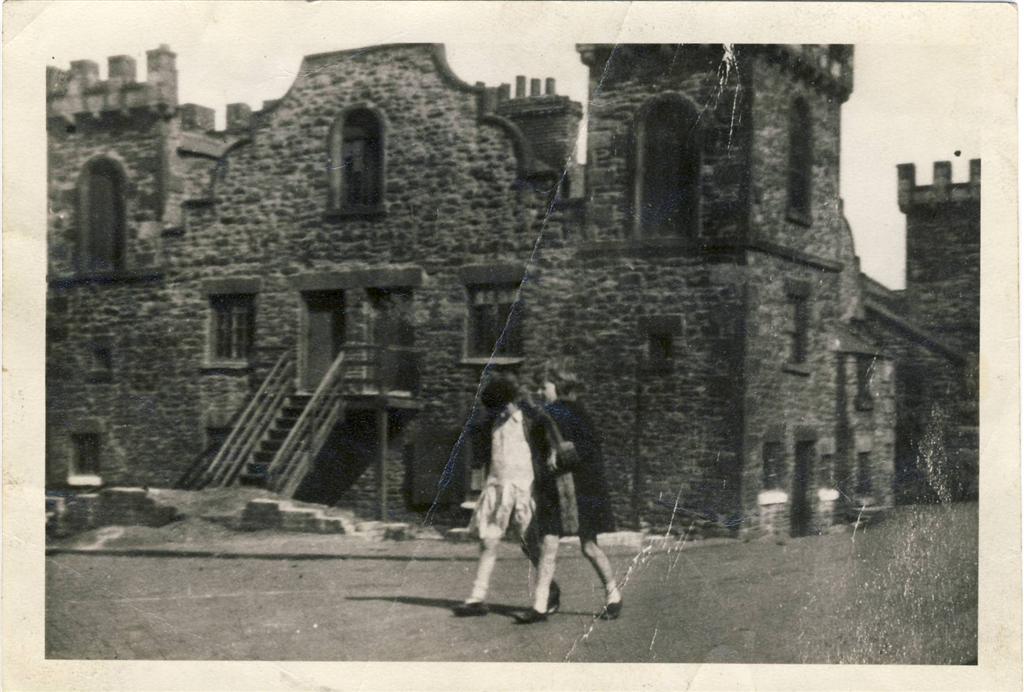
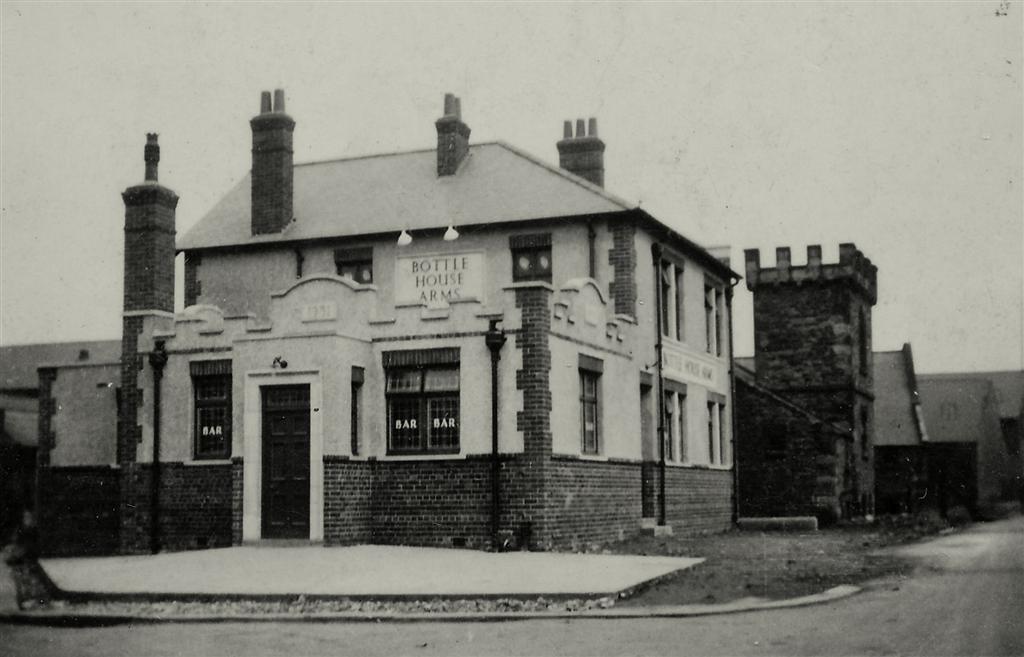
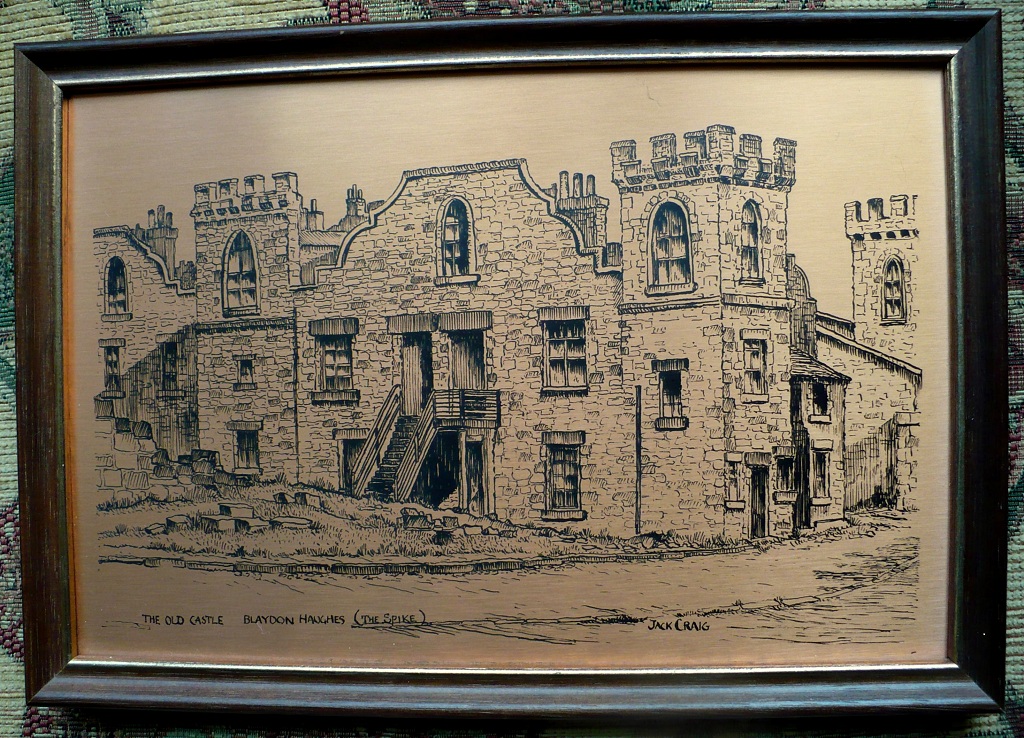
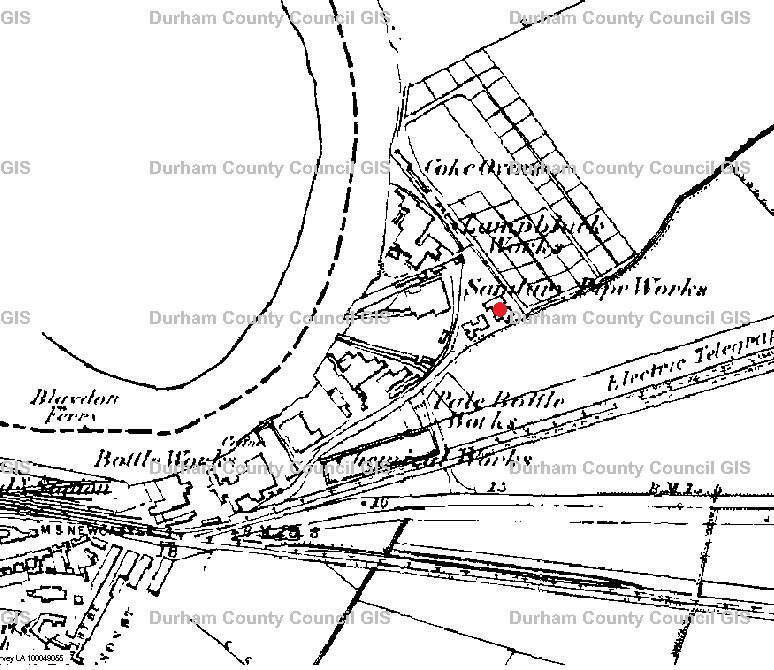
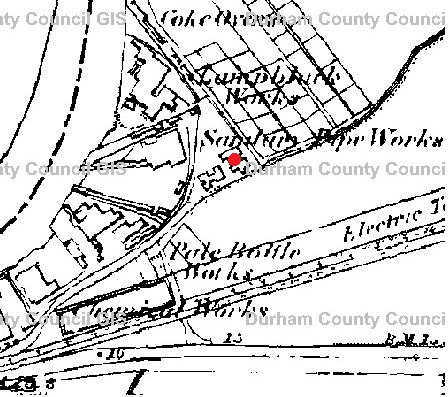
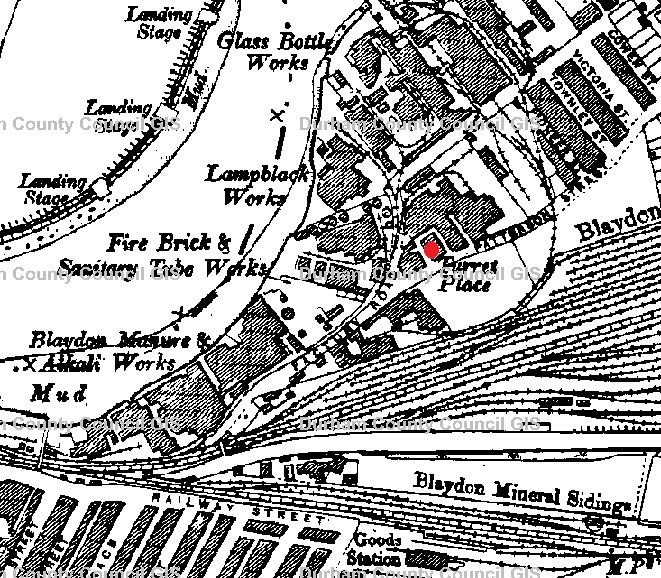
From the memories of Mary Green. With kind permission of Colin and Aileen Porrett and Mary's niece, Anne Jeavens. See full text in the essay on 'The Spike'.
The Spike was the name given to that part of the town also named Blaydon Haughs. 'Spike' is an Irish name for a lodging house, and the district was so called by the large contingent of Irishmen working locally and living there in the 1860s.
The original lodging house which gave The Spike its name was probably the building known as Blaydon Castle. Whilst not a military building it was of castellated structure and properly known as Turret Place. Although obviously a building of great pretensions in its later days in the 1880s it was made into tenements and housed eight families. The council's pre-war clearance resulted in its demolition. It was a large building, square in plan, of good quoining and rubble masonry which had a broad Dutch gable on each face with corbelled and crenellated turrets at each angle. Many of the original windows were large round headed openings and judging from these details the castle was built in the days of King Charles II.
We can hazard a guess as for which family the house or castle was built. It's site formed part of the Selby estate in Blaydon, this is shown on the map facing page 68 of our 'History of Blaydon', as Sir William Selby's Haugh. The castle stood in the waist of this plot. As a result of the Civil War and family tragedies, in the mid seventeenth century the Selby family entered upon hard times. Sir George Selby was forced to sell off his estate in parcels and as a result, the Claverings acquired the White House and adjacent lands and in 1675 the rest of the Selby share of the Lordship of Winlaton was bought by Sir William Blackett. But members of the Selby family continued to live in Blaydon for on the 4th January 1721, Mrs Frances Selby of Blaydon was buried in the choir of the church at Ryton. We think it highly probable the Selby's resided in the castle.
It was the late sixteenth century and the beautiful Mrs Francis Selby could often be seen walking from her castle along the banks of the River Tyne. She would stand smiling at the fishermen as they haulded in their nets full of the most beautiful salmon. The River Tyne at that time was a pleasure to behold clear, clean, glistening water in which the salmon excelled. Francis would undoubtedly return to her castle on the 'Haughs' and she would not be empty handed. She was thought very highly of by the workmen and all who knew her.
Let me tell you the history of this castle which was in that era the home of the Selby family. It was known as 'Blaydon Castle'. Whilst it was not a military building it was of castellated structure and was a building of great pretensions. It was square in plan, had good quoining and had a broad Dutch gable on each face with corbelled and crenellated turrets at each angle. The windows were large round headed openings. Its details all pointed to the castle having been built in the days of King Charles II.
The castle was built for the Selby family its site formed part of the Selby estate in Blaydon. Sometimes it was known as Sir William Selby's Haugh. As a result of the civil war and family tragedies, the Selbys fell on hard times and in the early seventeenth century were forced to sell off the estate in lots. These lots were bought by Sir William Blackett and the Clavering family. Members of the Selby family continued to live in Blaydon for in 1721 Mrs Frances Selby was buried in the choir of the church at Ryton. It was highly probable she still lived in the castle until her death.
The castle remained the home of the Selbys but later was deserted by them due to costs (of upkeep). In 1800 it was made into tenements and housed twelve families. It was said Frances Selby never did leave her castle as on more than one occasion she was seen by many gliding around, a ghostly apparition and still smiling.
Now getting on to the tenements. They were mostly occupied by Irishmen who got local work, for by this time Blaydon Haughs had turned into a hive of industry. Factories were popping up like mushrooms. There was a chemical works, a sanitary pipe works, three engineering works, a glass bottle factory and a lamp black factory. My forbears happened to be one of the families who lived in the tenements I myself was born there in 1917.
The tenements consisted of two large stone floored rooms and two very small rooms. The living room had a huge fireplace which had a large, round oven. The ceilings were heavily beamed, the beams must have been oak but were coal black with years of smoke. The walls were rough cast plastering so could not be wallpapered people kept them whitewashed. There was no hot water and no electricity. All the tenants had oil lamps. The oil man called each week with his oil drums on a horse drawn cart. The toilets were dry closets or 'netties'. Two men referred to as /midden men' came each week to clean these out. They shovelled the rubbish out from a small hatch at the back of the closet.
Each tenant had large tubs called 'poss tubs'. These stood outside the door and were used for washing clothes in and also for the family bath tub. Filling the tubs with hot water was quite a task, remembering that all the water had to be boiled in pans, kettles and whatever else could be used on the fire. It was a regular thing for either one woman or two who had their tubs filled to grab all the kids playing around and strip them, scrub them, wash their hair and send them off home to have their hair combed. Actually the tenants in the castle were one big family very close knit and protective of one another. None of the children came to any harm, as someone was always around to keep an eye on them as if they were their own.
Some of the men kept pigs, others had poultry and others had allotment gardens. There was always a pan of broth, a side of bacon and a roast of pory for everyone. The fresh eggs went mainly to the children and the very old.
The castle was on its own it was divorced from Blaydon by the railway at one side, divided by fields, as was the little village named The Spike.
Turret Place was sadly demolished as part of clearance of old properties and redevelopment by Blaydon Urban District Council in the mid 1930s. Now this remarkable building is just a fond memory of the few Spikers who remain.
On 7th Sept 2018 I went to see Spiker James Somerville's son Robert and he got talking about the Spike Castle (Turret House). His family used to live there. It seems fairly certain it was renovated by Sir Joseph Cowen and used as short term digs for navvies working possibly on the Tyne improvement work. Later the tenements were occupied by Spike families working in the local factories, Smith Patterson etc. He told me the story that went around at that time was that these navvies (who probably drank away most of their wages) used to come to the castle for digs for the night and if they could afford 1p they got in. If they could only afford 1/2 p they slept on the line ie. slept standing up and hanging on a rope. He said that was the origin of the saying 'I could sleep on a clothes line'. I came home and Googled this practice and found this info below on line (joke!) about poor folk in London "if someone was so poor that even 4d was beyond reach, they could sleep standing up, behind a rope fixed at chest height along the wall, for 2d the origin of the saying he / she could sleep on a clothes line. Its a stark reminder of how harshly poverty afflicted people at that time".
Roly Veitch
9th January 2013 (updated 6th January 2021)
For more information on our local area history, our unique dialect, our wealth of dialect songs and other topics please visit the home page menu - link below.
Back to History Menu Page